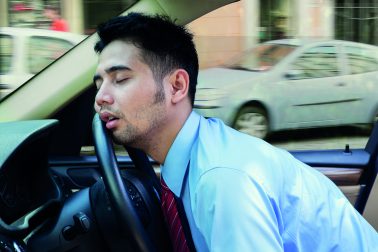The dangers of driving tired
 We have all had moments of sleepy inattention while driving, especially on long, straight motorways when the drive gets monotonous and you are tired after a long day.
We have all had moments of sleepy inattention while driving, especially on long, straight motorways when the drive gets monotonous and you are tired after a long day.
However, even though most of us have experienced driving while fatigued, doing so can be extremely dangerous. Studies have shown that one in six crashes resulting in death or injury on major roads is related to fatigue. In addition, roughly 40% of fatigue-related crashes involve commercial vehicle drivers. As commercial vehicles are some of the largest and heaviest vehicles on the road, they are likely to cause significant damage in a crash.
When can crashes occur?
While crashes can occur at any point of the day, there are certain times when collisions are more likely to occur. The two peak timeframes when crashes are most likely to occur are from 02:00-06:00 and 14:00-16:00. These are times when we all experience natural waves of sleepiness – late at night and right after lunch, in the middle of the afternoon.
Studies have also found that individuals who are driving at 06:00 are 20 times more likely to fall asleep while driving than they are at 10:00. Humans naturally have less energy at these times, as the human body experiences peaks and dips through the day and night.
What kind of drivers are most at risk?
While all drivers have likely experienced driver fatigue, commercial drivers spend more time on the road than your average commuter and they are often driving on long, monotonous motorways for extended periods.
What does the law say?
Unlike driving while under the influence, it can be very difficult for investigators to prove that a driver was asleep at the wheel. The driver may not want to admit to having fallen asleep at the wheel, or the driver may have died in the crash. However, drivers who have killed someone while asleep at the wheel can face maximum charges of 14 years in prison.
There are additional laws in place for commercial vehicles, which UK companies operating large commercial fleets need to be aware of. Under the Management of Health and Safety at Work Regulations (1999), employers are charged with assessing all risks involved in driving and road use – this means that employers need to assess the drivers and trips that are at risk for driver fatigue and adjust their schedules and expectations accordingly.
What are the signs of fatigue?
Most people are aware of the general signs of fatigue and sleep; however, many people underestimate the dangers of driving while sleepy, and continue to drive. Signs of fatigue can include:
- Difficulty concentrating.
- Heavy eyelids.
- Eye movements relaxing or “rolling”.
- Relaxation of neck muscles, causing the head to droop or nod.
Are there any medical causes for driver fatigue?
While most driver fatigue is the result of monotonous roads, late hours and not enough sleep, there are some medical conditions that can add to fatigue experienced while driving. Sleep disorders, such as narcolepsy, insomnia or sleep apnoea, can all add to fatigue and make driving even more dangerous. However, just one night’s interrupted or incomplete sleep can also worsen an individual’s ability to concentrate while driving for long periods of time. Additionally, some prescription and over-the-counter medications can cause fatigue and decrease alertness.
How can fatigue be mitigated by drivers?
While the simplest way to avoid driver fatigue is to get a good night’s rest, this is not always possible – especially for commercial drivers. However, there are a number of ways in which drivers can combat driver fatigue:
- Caffeinated beverages, such as coffee or an energy drink, can reduce tiredness and increase alertness for a short period.
- 15-minute naps, when possible, are even more effective at fighting fatigue than taking a quick break to walk around the car.
- Planning your journey to include multiple breaks and rest stops is a great way to ensure that you will have coffee and nap stops when you need them.
What are the best practices for employers looking to help their drivers combat fatigue?
One of the easiest and most important things employers can do to help their drivers combat driver fatigue is to train and educate their drivers. If drivers are aware of the warning signs of driver fatigue and are trained in the correct protocol to follow when they feel fatigue coming on, they will be better equipped to handle fatigue in a safe way.
Additionally, employers can choose to include in-vehicle technology to combat driver fatigue. Driver Distraction and Drowsiness Recognition (DDDR) is a monitoring system that tracks driver eye and head movement for signs of drowsiness. If a driver begins to slowly close their eyes or nod their head, the system will warn the driver and tell them that they need to take a break.
